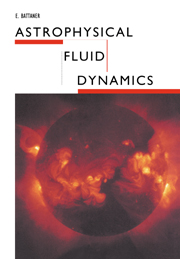Book contents
6 - THE FLUID OF STARS
Published online by Cambridge University Press: 05 June 2012
Summary
The fluid of stars
In contrast with the fluid in a star, defined as the fluid of which stars are constituted, we will now deal with a fluid of stars, defined as a fluid whose microscopic particles are stars. Our first example will be a galaxy. It is true that a galaxy is not composed solely of stars. It also possesses gas and dust in different amounts, and gas influences the dynamics of the star system decisively. However, as an introduction to galactic dynamics we will first study the dynamics of the stellar system, then that of the interstellar gas, and will finally try to combine the two. In this chapter, those terms in the hydrodynamical equations that are not influenced by the presence of gas will be considered.
Galaxies are not the only examples of fluids of stars. Globular clusters and even open clusters can be systems with these characteristics. Clusters of galaxies can also be analysed using the same theoretical approach, with the stars being replaced by galaxies, that is, assuming a fluid of galaxies. The galactic scenario is assumed in general here, but other types of stellar system will be considered. The number of stars in our Galaxy is of the order of 1011, a sufficiently large number to justify the use of hydrodynamics.
A great simplification in the hydrodynamical equations consists of azimuthal or axial symmetry, which is appropriate for the majority of galaxies.
- Type
- Chapter
- Information
- Astrophysical Fluid Dynamics , pp. 133 - 146Publisher: Cambridge University PressPrint publication year: 1996



